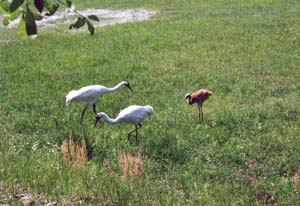Whooping Cranes
Air Date: Week of April 26, 2002
It's not every day a pair of endangered whooping cranes sets up house in a suburban backyard. Host Steve Curwood talks with Gene Tindell about the cranes raising a chick just 50 yards from his back door.
Transcript
CURWOOD: You’re listening to NPR’s Living on Earth. Think, for a moment, how you might feel looking out your window and seeing a pair of four foot tall endangered whooping cranes building a nest 50 yards away. That’s what happened to Gene Tindell at his home in Leesburg, Florida. And now, the cranes are raising a chick, only the second successful hatching in the wild by captive-bred parents.
Mr. Tindell, please tell us about the place these birds have chosen to call home. What does it look like?
TINDELL: It’s a small, about a 30 acre lake out here. And we had a drought. And, it’s just turned into--from a lake to a marsh.
CURWOOD: Now, why do you think they picked your house, these whooping cranes?
TINDELL: Well, the Game and Fish Commission really didn’t approve of this. But, we have mallard ducks back here. And, I would feed them cracked corn everyday. And I guess when the whooping cranes came over, they saw the cracked corn. The Game and Fish Commission said it was just like being on the interstate and seeing a McDonald’s sign out when you’re starving to death. They’ve been here ever since.

(Photo: Gene Tindell)
CURWOOD: They had a baby, huh?
TINDELL: They had two. The first one was hatched overnight on March the 12th. The second one was hatched overnight on March the 14th. But on the 15th, about 8:30 in the morning, the bald eagle took chick number two off the nest.
CURWOOD: Ooh, how did that feel to see that?
TINDELL: Oh, it broke my heart.
CURWOOD: Now, I’m wondering if you feel like an honorary grandfather to them.
TINDELL: [Laughing] I feel like it.
CURWOOD: Are you handing out cigars?
TINDELL: No, but the Game and Fish Commission brought me two. And, they’re not sure whether this one is a male or female. So they brought me "It’s a Boy, It’s a Girl."
CURWOOD: So, what do you do if you’re a human grandfather to a whooping crane chick? How are you supposed to act?
TINDELL: I don’t know. Mostly observe. And, people come by and want to see them. I let them come in the yard, and give them a better view of the chick.
CURWOOD: What about the predator situation there?
TINDELL: Well, if I see the bald eagle flying around overhead, I walk down to the edge of the marsh, and stand there until he leaves. But, I try to protect him as much as I can.
CURWOOD: Is there a name, by the way, for this baby?
TINDELL: Yes. Lucky. He was lucky he wasn’t sitting on the nest the morning the bald eagle came by. My wife gave him that name.
CURWOOD: What’s it going to be like to see Lucky fly away one day?
TINDELL: It’s going to be heartbreaking. But, hopefully, we’ll get to see him again. If the marsh stays as it is now, there’s a good chance that this same pair will come back here this next year, and nest again. So hopefully, we’ll see them again.
CURWOOD: Gene Tindell watches the whoopers from his home in Leesburg, Florida. Thanks for the birdseye view, Gene.
TINDELL: Thank you.
[SOUND OF BIRDS]
Links
Living on Earth wants to hear from you!
Living on Earth
62 Calef Highway, Suite 212
Lee, NH 03861
Telephone: 617-287-4121
E-mail: comments@loe.org
Newsletter [Click here]
Donate to Living on Earth!
Living on Earth is an independent media program and relies entirely on contributions from listeners and institutions supporting public service. Please donate now to preserve an independent environmental voice.
NewsletterLiving on Earth offers a weekly delivery of the show's rundown to your mailbox. Sign up for our newsletter today!
 Sailors For The Sea: Be the change you want to sea.
Sailors For The Sea: Be the change you want to sea.
 The Grantham Foundation for the Protection of the Environment: Committed to protecting and improving the health of the global environment.
The Grantham Foundation for the Protection of the Environment: Committed to protecting and improving the health of the global environment.
 Contribute to Living on Earth and receive, as our gift to you, an archival print of one of Mark Seth Lender's extraordinary wildlife photographs. Follow the link to see Mark's current collection of photographs.
Contribute to Living on Earth and receive, as our gift to you, an archival print of one of Mark Seth Lender's extraordinary wildlife photographs. Follow the link to see Mark's current collection of photographs.
 Buy a signed copy of Mark Seth Lender's book Smeagull the Seagull & support Living on Earth
Buy a signed copy of Mark Seth Lender's book Smeagull the Seagull & support Living on Earth

